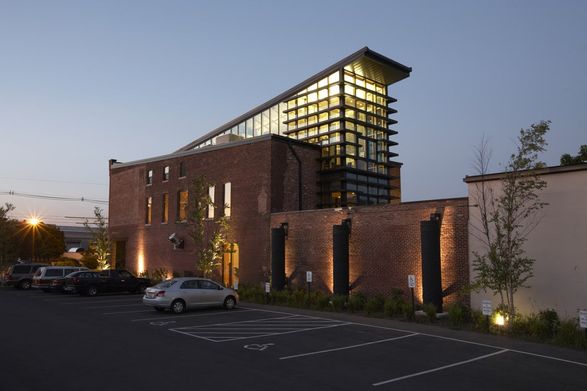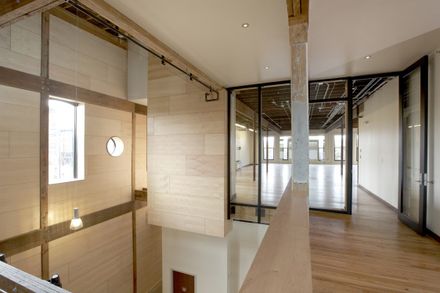
The Green Building
MANUFACTURERS
Dornbracht, Hansgrohe, Lutron, Duravit, Guardian Glass, HE Williams, Miele, Sherwin-Williams, Subzero/Wolf, Architectural Building Products, Asko, Bartco Lighting, Blanco, Blum, Danze, Decolav, Detecto, Fleetwood, Gaggenau, Garage Door Brokers, +7
GENERAL CONTRACTOR
Peters Construction
LOCATION
Louisville, Kentucky, United States
CATEGORY
Office Buildings, Adaptive Reuse
PROJECT YEAR
2008
AREA
10175.0 ft2
Text description provided by architect.
Based on the idea that sensible architecture emerges between spatial and programmatic relationships, (fer) studio designed the project to instill an experience of place within the surrounding environment.
Establishing a design order enabled the sustainable features of the project to fall into place and set up a natural codependency between design and sustainability.
The Green Building is the first LEED Platinum project in the city of Louisville and the first LEED certified adaptive re-use project in the state of Kentucky.
As a result, the 115 year old former dry goods store transformed into The Green Building, a 10,175 sqf mixed-use commercial building housing a gallery, event space, offices, tenant office spaces, conference room, and a separate tenant restaurant space.
Completed in the fall of 2008 and located in the East Market district of Louisville, a federally classified distressed area at the time of purchase and construction, The Green Building has become the catalyst to the reinvigoration of the district, now the hip city center for arts and sustainability, coined NuLu, or ‘New Louisville.’
INNOVATIVE RE-USE DESIGN
Understanding the history of the building and the context of the neighborhood, (fer) studio inventoried the existing building components to determine its weak points.
Elements of the building were carved away to allow a new re-use form to emerge Triple height volumes adjacent to single stories activate a sense of openness by being next to an adjacent compressive (and more intimate) space.
New construction defers to old at the historic front façade of The Green Building and incrementally reveals a new formal arrangement as visitors filter through the spaces towards the rear of the building. In the center, all components, both spatial and technical, merge into the design core, which visually connects to every space in the building.
WATER-EFFICIENCY
No city water is used by The Green Building’s xeriscape landscaping. Storm water is either absorbed by the green roof, collected in three large rain barrels, or directed into a rain garden, where the toxins are removed by plant material before reentering the ground water system.
ENERGY-EFFICIENCY
The Green Building saves 30,000 pounds of CO2 a month, more than enough to offset the carbon footprint of all its employees’ vehicles. Thanks to 81 solar panels, a 1,100 gallon ice storage system, and twelve geothermal wells 225 feet underneath the building, The Green Building’s total off-grid energy efficiency is up to 68% and it outperforms Kentucky energy codes by up to 65%
RE-USED MATERIALS
In addition to saving the original mortar shell of the structure, The Green Building team re-used much of the material from the original building. For example, structural wood from the original building was re-milled into finished flooring and furniture. Bricks from the original building were carefully disassembled and re-used in other areas of the remodel.
RECYCLED MATERIALS
The Green Building includes a high percentage of recycled materials, including 100% of the flooring, 70% of the windows, and 80% of the insulation, made from recycled blue jeans. The team diverted 551 cubic yards (3cy2) of demo material from the landfill by donating to local salvage yards, construction companies, a nearby farm, and Habitat Restore for Habitat.























